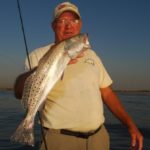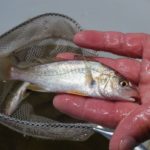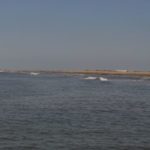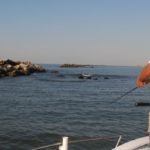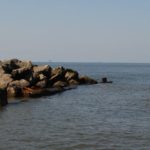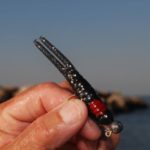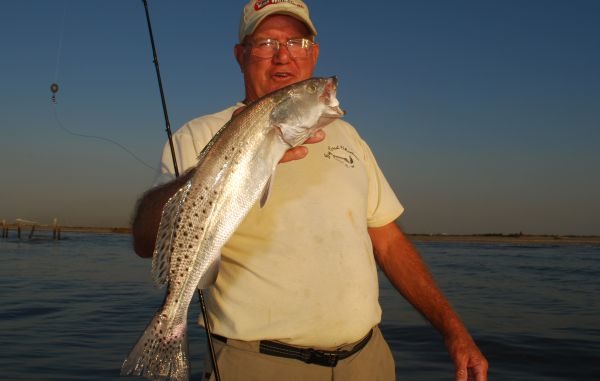
There’s a reason why the venerable baitfish is this Grand Isle guide’s favorite.
“I fish live bait — live croakers,” the 68-year-old says with conviction, as if looking for a challenge. “Using plastic can be a good way to find the fish,” he adds, seeming for a moment to soften a bit, “but when I find them, I throw croakers to catch more. The reason I don’t stay with plastic is to catch bigger fish. You gotta remember that I like bigger fish.”
Carol “Zutie” Auenson can afford to ooze self-confidence. The box beneath him is thumping with speckled trout showing their displeasure with being introduced to ice. Not a cloud mars the sky as the boat rocks easily in the gentle beach swell near Grand Isle, summertime headquarters for the veteran fishing guide. The break of the small waves on the beach sounds like the crinkling of crepe paper. The water is “trout green.”
Earlier that day, Auenson had his boat launched well before daylight, but like the old bull that walked down the hill rather than run down it, he sat patiently in the dark tying leaders. He explained that he needs enough light to see well when he runs down the beaches. He wants to be able to see signs of feeding fish or interesting current patterns.
Soon enough, he is running out of Caminada Pass. The sky to the east is aflame with outlandish colors — fuchsia shading to lavender — like a Van Gogh painting. Out of the pass, he hangs a right to gently coast 75 yards out along the Elmer’s Island beach.
He responds to an almost imperceptible flick on the water’s surface. “Ooh, ooh, I thought I saw a trout hit.”
He instantly curls the boat offshore and back around and shuts the big engine down. Using his trolling motor, he eases to within casting distance of where the waves are gently breaking over an inner sand bar paralleling the beach, then drops his anchor. Early in the morning he tries to get as close to the beach as possible, as long as the water isn’t dirty.
While jockeying the trolling motor, he jabs a kahle hook through the flesh above the tail and under the dorsal fin of a lively 3-inch croaker.
“Sometimes, I hook croakers through the lips,” he explains, “but they swim better when hooked in the tail.”
As soon as the bait hits the water, he hooks a fish and then just as quickly loses it. Then he catches one trout, then another. He complains that the specks are bumping the bait and just barely picking it up.
He displays a delicate touch with the rod, very slowly and gently picking it up and dropping it and then retrieving the slack, always in touch with the bait. Only when he feels that a fish has the bait well in its mouth does he set the hook.
Then to his obvious annoyance, a porpoise pops up between the boat and the beach.
“Ohh, that’s gonna be the end of it — a porpoise moving through,” he grunts.
And it was.
With the sun still not over the horizon, Auenson picks up the anchor and moves up the beach farther to a spot marked by several clusters of pilings.
“This is a pretty popular spot with anyone who knows how to fish here,” he said. “It’s the LOOP [Louisiana Offshore Oil Port] Pipeline, but we just call it ‘the pipeline.’”
He anchors farther from the beach here, slightly over 100 yards out and not particularly close to any pilings.
“I don’t get very close here,” he says as he casts toward the beach. “It’s always a little rough and dirty here.”
He starts catching trout immediately, 15-inchers that he calls “pee-wees.”
He tutors as he catches and boxes fish.
“I like to fish in most places on the beach right where the wave breaks on the sandbar,” he said. “That is where the bigger fish are.
“There’s people that come out and fish and don’t look for any sign.”
He notes that he loves to see shrimp popping out of the water. He watches closely for trout striking “bait,” as he calls anything edible to a speck. He especially likes schools of minnows, which he calls “shiners,” and says emphatically “trout love to eat them.”
Auenson says that schools of mullet are not a tell for him, but quickly admits that trout do indeed eat mullet. When fishing on the beaches, he will also immediately stop to fish under flocks of feeding gulls, something he seldom does in interior bays. Bird trout on beaches average larger and don’t move as much as they do in the inside.
He soon tires of catching middling size trout and suggests a move farther up the beach to “the barges.” These are a broken line of rock-filled barges that the Lafourche Port Commission sank off the Fourchon beaches as breakwaters to reduce shoreline erosion. The barges, once largely intact, have now rusted away, and many of the rocks from their bowels have been tumbled beachward.
Fishing a live-bait rig on the bottom on the shore side of the barges is nearly impossible because of the hang-ups, explains Auenson, as he begins casting his favorite plastic lure, a smoke/glitter sparkle beetle on a 1/4-ounce jig head. Another change in tactics is a complete abandonment of the use of an anchor. As he fishes, he constantly moves the boat with his trolling motor.
“You can catch many good fish here,” he says quietly as he sets the hook on a respectable speck.
Each barge produces a couple of fish — no more, no less. At the westernmost barges, he moves to the Gulf side, anchors and offers a live croaker on a Carolina rig to a willing trout. You can fish live bait without hanging up outside the barges, but not on the beachside, he explains.
Then he is back on the inside, casting plastics. He moves a lot. The pattern seems to be: Catch 1, 2 or 3, then move. Most of what he catches are what he calls “healthy trout,” averaging about 1½ pounds. From there it is to the rocks at the Belle Pass jetties, then back to the easternmost barges (his favorites), the LOOP Pipeline and a couple of spots with bait activity.
Fishing the beaches with the veteran captain is not just productive, it is aesthetically pleasing — the rolling splash of the small waves on the beach, the lulling gentle breeze and the musical notes of laughing gulls.
And then there is Zutie.
Spry and agile, he hasn’t taken a seat all day. While the skin on his bare arms is the color and texture of finely tanned leather, his face is creased only by his perpetual smile.
“I’ve been fishing a long time,” he admits, “but I’m not ready to quit yet. I love to catch speckled trout!”
Capt. Zutie Auenson is a featured angler in the upcoming book, Trout Masters Too: How the Pros Do It.” His guide service, Bay Coast Charters, may be reached at 985-637-3692.
